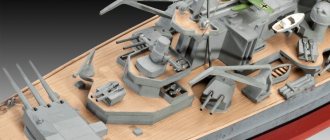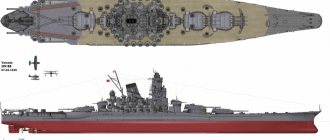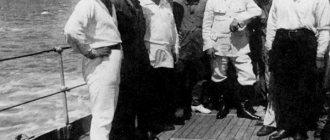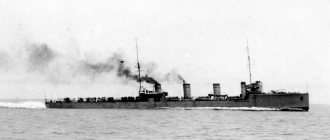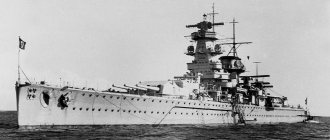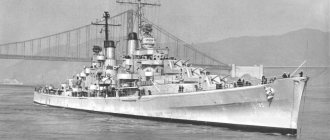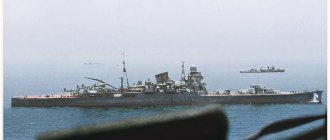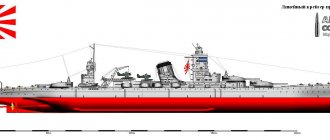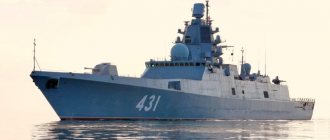"Congo": the end of the legend
By the beginning of World War II, the Kongo-class battleships had become the oldest dreadnoughts of the Imperial Japanese Navy. However, of all the Japanese battleships, they took the most active part in the hostilities and inflicted the most significant damage on the enemy.
Old but fast
By December 1941, Kongo-class battleships occupied a rather unique niche in the Japanese fleet: in terms of speed (30 knots), they were quite modern ships, being at the level of the best battleships of that time. In terms of artillery caliber (356 mm), they were also on a par with the ships of their era, in the Japanese fleet second only to the battleships Nagato and Mutsu, as well as the giants of the Yamato type that had not yet been commissioned.
Battleship Kongo in 1944 Source: Masataka Chihaya and Yasuo Abe. IJN Kongo/Battleship 1912–1944 – Warship Profile #12
But in terms of the thickness of the armor belt (203 mm), the Congo-class ships remained almost at the level of the notorious English battlecruisers of the Battle of Jutland era. Even the strengthening of horizontal armor, carried out during the modernization of the early 30s, did not help. Theoretically, the total thickness of the decks within the citadel (140–160 mm) was enough to protect against 356 mm shells of old American battleships at distances of up to 150 mm. However, due to the fact that the new armor plates had to be laid deep in the hull, the engineers were unable to ensure sufficient integrity of the lower armored deck. In addition, eight 14-inch guns were clearly not enough for a battleship - old American and Japanese battleships each carried twelve such guns, and old English battleships carried eight 15-inch guns.
The main gun of the battleship Kongo. By 1942, these 356 mm guns were already inferior to the artillery of the newest American battleships. Photo from the author's collection
Paradoxically, it was precisely this “inferiority” of the Kongo-class ships that provided them with a stormy combat biography. Not counting on them as significant help in the upcoming general naval battle, the command of the Japanese Combined Fleet did not “shake” over them and was not afraid to actively involve them in strike operations in the first period of the war, and the high speed of these ships allowed them to operate together with cruisers.
The first year of the war: from Pearl Harbor to Ceylon
Hiei and Kirishima, along with two heavy cruisers (Tone and Chikuma), formed the core of Admiral Nagumo's Carrier Strike Force support force during the attack on Pearl Harbor. Kongo and Haruna, along with four heavy cruisers (Atago, Takao, Maya and Chokai), were based in Cam Ranh Bay, covering operations in the South China Sea - first the landing in Malaya (Congo) ) and Borneo ("Hiei"), and then the invasion of Luzon, which led to the fall of the Philippines.
From Malaya to Ceylon. Actions of the Japanese fleet in the Western Pacific and Indian Ocean in December 1941-April 1942 Source: Marine Atlas. Volume III, part two. Publication of the General Staff of the Navy, 1963
In January 1942, Hiei and Kirishima took part in the capture of Rabaul - they covered aircraft carriers that attacked this British base on the island of New Britain and the port of Kavieng on New Ireland. In early February, both battleships tried to intercept the American aircraft carriers Yorktown and Enterprise, which were leaving to attack the Mariana Islands.
At the end of February 1942, all four Kongo-class ships reunited as part of Admiral Nagumo's Strike Force, which supported the Japanese invasion of Java. On March 1, the Congo, together with the heavy cruiser Tikuma, sank the American destroyer Edsall, and on March 7, together with the Haruna, shelled the British Christmas Island.
In April 1942, the battleships took part in the famous raid of Admiral Nagumo's aircraft carrier formation into the Indian Ocean. It is one of the three seaplanes "Aiti" type 0 mod. 1 (E13A) from the Haruna on April 8 discovered British ships off the east coast of Ceylon that had fled from Trincomalee - the light aircraft carrier Hermes, the destroyer Vampire, the corvette Hollyhock, the tanker British Sargent and the mother ship Athelstan. All of them were destroyed by a raid by ninety Japanese carrier-based bombers.
New Guinea and Solomon Islands. Red circles indicate Japanese bases as of August 1942 Source: ibiblio.org
In early June 1942, all four battleships took part in the Battle of Midway: Haruna and Kirishima were part of Vice Admiral Nagumo's Carrier Strike Force, and Kongo and Hiei, along with heavy cruisers, were part of Vice Admiral Nagumo's Support Force Condo. After the unsuccessful completion of the operation, the ships returned to the metropolis, where they underwent repairs and modernization at the Kure Naval Arsenal: type 21 mod air detection radars were installed on the Kongo and Kirishima. 1 (on top of the command and rangefinder post on the bow superstructure).
In October 1942, all four battleships were sent to Rabaul, where Kongo became the flagship of Vice Admiral Kurita's Forward Force. Kurita's task was to directly support Japanese troops on the island of Guadalcanal - at a key point in the Japanese defensive perimeter, where the best troops of the Land of the Rising Sun clashed with the elite of the American Marines.
Henderson Field (the main target of Japanese attacks on Guadalcanal), August 1942. Photo from the US National Archives
On October 13, "Congo" and "Haruna" reached Guadalcanal and on the night of October 14 fired at Henderson Field airfield, firing 430 and 483 special high-explosive fragmentation shells, respectively. During the night shelling from the sea and the Japanese bomber raid that preceded it, 48 American aircraft out of 90 were completely destroyed, and most importantly, almost all gasoline reserves were burned. This strike became one of the most striking successes of the Japanese in the battles on the island: the temporary disabling of the airfield allowed Japanese transports with troops to unload literally a dozen kilometers from it on October 15. Large reinforcements were landed ashore: the 16th Regiment of the 2nd Infantry Division and part of the 230th Regiment of the 38th Infantry Division arriving from Indonesia (a total of about 4,500 people with ammunition and food). From this point on, Japanese troops on Guadalcanal began to strengthen faster than the American ones.
Friday the thirteenth…
On November 12–15, 1942, all four battleships took part in the decisive naval battle for Guadalcanal. "Kongo" and "Haruna" as part of the Support Formation were located north of the Solomon Islands, covering the aircraft carriers "Hiyo" and "Zunyo", and did not take direct part in the artillery battle. But “Hiei” and “Kirishima” fell into the thick of things. Together with the light cruiser Nagara and fourteen destroyers, they became part of Vice Admiral Abe's Volunteer Strike Force, which flew its flag on the Hiei. While high-speed transports (former destroyers) leaving Buin Island were unloading troops, ammunition and food at Cape Tassafaronga, Abe's formation was to fire twice at Henderson Field airfield and unloading American transports (on the night of 12/13 and on the night of 13/14 November ). To maximize the effectiveness of the strike, Admiral Abe decided to take a risk: the battleships were loaded with mainly high-explosive fragmentation shells for shelling the shore, and they were also raised into the reloading compartments, while the armor-piercing ammunition remained below.
On the evening of November 12, a storm broke out, disrupting the formation of Japanese ships and scattering the covering destroyers. After midnight, at 1:21, the destroyer Yudachi suddenly discovered American ships - Admiral Callahan's detachment: three heavy and three light cruisers, as well as eleven destroyers. Admiral Abe ordered a hasty change of shells - the situation was reminiscent of the rearmament of Nagumo's aircraft at the Battle of Midway.
The battle at Guadalcanal on the night of November 13, 1942. Maneuvering Hiei and Kirishima Source: The Campaigns of the Pacific War
However, for the Americans, the meeting also turned out to be unexpected: their best search radar, located on the cruiser Helena, detected the enemy three minutes later than the Japanese observers. A chaotic battle ensued, during which the enemy ships were mixed up; The cruisers fired from a “pistol” distance of 15–25 kb, at which the side armor of the Japanese battleships could no longer protect against 203 mm American shells.
At the same time, 356-mm shells from the battleship Hiei fell on the American light cruiser Atlanta, which was heavily damaged and sank closer to the morning (it killed the commander of Task Force 67.4, Rear Admiral Scott, and his staff). However, by doing so, the Japanese battleship revealed itself, after which most American ships, including destroyers, concentrated fire on it. Admiral Abe lost control of the battle and managed to order a retreat, after which enemy shells destroyed the radio station.
Light air defense cruiser Atlanta refueling from heavy cruiser San Francisco, October 16, 1942 Source: ibiblio.org
With this shooting, the American ships, in turn, revealed themselves, after which the Kirishima, which remained unnoticed, opened fire on the flagship heavy cruiser San Francisco. The shells destroyed all the main caliber towers and hit the battle bridge, where another admiral was killed - the commander of the American formation, Rear Admiral Callahan. The Japanese battleship itself received only one hit from a 203-mm shell in response.
Control of the battle was lost on both sides, and now each ship fought alone, and the commanders made decisions depending on their understanding of the situation. The destroyers Yudachi and Amatsukaze each fired eight torpedoes; One torpedo from the Yudachi hit the stern of the heavy cruiser Portland, but the Japanese destroyer itself was covered in fire and sunk. A torpedo from the Amatsukaze hit the destroyer Barton, which exploded and sank. After this, the Amatsukaze was able to set fire to the light cruiser Juneau with the fire of its 127-mm guns, but came under a hail of 127-mm shells from the cruiser Helena and sank. The Helena came under fire from Japanese destroyers, and she also withdrew from the battle, but survived. But the damaged Juneau was less fortunate: the next morning, while leaving, it was sunk by the Japanese submarine I-26.
Heavy cruiser Portland undergoing repairs in Sydney a month after the battle Source: navsource.org
Gradually the battle died down - the enemy ships dispersed in different directions. In addition to the Yudachi abandoned by the crew, the Japanese lost the destroyer Amatsukaze, which perished with its entire crew. The Americans were missing four destroyers (Barton, Cushing, Monssen and Laffey). Before noon on November 13, two light cruisers were added to the list of American losses, and one heavy cruiser was out of action for a long time.
The Japanese were in for even greater misfortune. The Hiei was located north of Savo Island, its steering was disabled, but the ship was moving, and the Japanese sailors hoped to save it. However, on the afternoon of November 13 (Friday), the battleship was discovered by American planes, after which a series of air raids followed. It was now that the Americans had complete dominance in the air. By 14:30 the battleship had lost steam, and at 18:00 the order came to remove the crew from the ship and scuttle it.
Break at Guadalcanal
Meanwhile, a new convoy was heading towards Guadalcanal - this time consisting of large slow-moving transports. It was carrying two regiments of the fresh 38th Infantry Division (228th and 230th) and was scheduled to reach the landing site at Tassafaronga Point on the night of 15 November. The main danger to transport on the approach to the island was posed by American aircraft from Henderson Field, so Admiral Abe decided to continue the operation against the airfield, reinforcing his detachment with the cruisers of Admiral Mikawa (Union of the Outer South Seas).
On the night of November 14, the heavy cruisers Chokai, Maya and Suzuya fired high-explosive fragmentation shells at the Henderson Field airfield and, undetected by the enemy, retreated to join the rest of the forces. However, in the morning, American dive bombers from Guadalcanal attacked Mikawa’s detachment and sank the heavy cruiser Kinugasa. If at night the Japanese could resist the Americans and even inflict serious losses on them, then during the day, without serious air cover, they were powerless against enemy aircraft.
A Japanese detachment marches towards Guadalcanal, November 14, 1942. The photo was taken from the cruiser Atago, with the cruiser Takao and the battleship Kirishima visible in front. Source: Tameichi Hara. Japanese Destroyer Captain. Ballentine Books, 1961
Therefore, Admiral Kondo made his last bet on a night battle. Now ahead of his formation was a long-range guard consisting of the light cruiser Sendai and three destroyers. On November 14 at 22:10, ten miles northeast of Savo Island, they discovered enemy ships. And again, American radars gave way to Japanese observers - the Americans discovered the enemy patrol only at 22:52.
The battle was again chaotic as Japanese ships encircled Savo Island on both sides. Japanese destroyers fired torpedoes, sinking the destroyer Walk, and their leader, the light cruiser Nagara, sank the destroyer Preston with 140 mm shells; The destroyer Benson was hit by a torpedo and sank the next day. The Japanese lost the destroyer Ayanami.
But at 23:40 the Japanese discovered that they were facing something more than heavy cruisers: the newest American battleship, South Dakota, appeared in the beams of their searchlights.
Battleship South Dakota Source: US Fast Battleships 1936–1947. Osprey Publishing 2010 (Osprey New Vanguard #169)
Kirishima, the only battleship Abe had left, was two whole generations older - it had eight 356 mm guns versus nine 406 mm guns, obviously weaker armor and was only slightly superior to the enemy in speed. But the Japanese took advantage of the chance presented to them and opened fire first. “South Dakota” received several hits from heavy shells, fires broke out on it, and most importantly, the fire control system failed. Having lost 39 people killed and 59 wounded, the American battleship left the battle. The repair of the ship lasted three months - until February 1943.
Battleship Washington fires at Kirishima Source: navsource.org
Having opened fire, the Kirishima also revealed itself. And lurking in the darkness was another American battleship, the Washington, which was following in the wake of the South Dakota. At 0:05, his 406-mm shells from a distance of 40 kb fell on the Japanese veteran. Over the next seven minutes, the Kirishima received at least nine hits from 16-inch shells, its rudder jammed, the ship lost speed and began to take on water. Realizing the terrifying superiority of the enemy, Admiral Kondo decided to stop the operation: at 0:30 he ordered the destroyers to remove the crew from the Kirishima and retreat to the northeast. No attempts were made to tow the battleship, but it stayed afloat for another three hours and sank only at 3:23, seven miles northwest of Savo Island. 284 people died on the battleship, and another 84 of those who survived were injured.
The battle at Guadalcanal on the night of November 15, 1942. Battleship Duel Source: The Campaigns of the Pacific War
Meanwhile, the transports of the Japanese convoy approached Cape Tassafaronga - after the daytime raids by American aircraft, only four of the eleven remained. But they too, fired upon by artillery from American destroyers, were forced to throw themselves ashore. In total, a four-day supply of rice and 2,000 men (out of 10,000 soldiers of the 38th Infantry Division) were delivered to Guadalcanal. About 5,000 people died.
Japanese transports "Hirokawa-maru" and "Kinugawa-maru", washed ashore at Cape Tassafaronga Source: wwiiarchives.net
"Kongo" and "Haruna" did not take part in the battle. It is difficult to say how it could have ended if Vice Admiral Kondo had thrown them into battle along with Hiei and Kirishima. It is unlikely that the Japanese would have been able to sink the newest American battleships, but one can assume that the fate of the convoy heading to Guadalcanal would have been different. And the landing of the fresh 38th Division gave the Japanese a chance to hold on to the island and, perhaps, achieve success in the battles for Henderson Field.
Transport "Kinugawa Maru" a year after the battle Source: history.navy.mil
It was the naval battle of Guadalcanal that became the turning point of the war in the Pacific. Until “Friday the Thirteenth,” the Japanese were attacking, and the Americans were defending, the Japanese fleet was active and, in general, more successful, and until mid-November 1942, the Japanese managed to build up their forces on the island faster than the Americans did.
Slow sunset
At the end of November 1942, "Kongo" and "Haruna" were sent to the metropolis and again put for routine repairs, combined with modernization: the number of 25-mm anti-aircraft guns on the ships was increased to 34; installed infrared night vision devices and surface detection radar type 22 mod. 4.
Throughout 1943, Kongo and Haruna did not participate in battles. In March, two 152-mm casemate guns (seventh and eighth) were removed from the Kongo, and six 152-mm guns from the Haruna. Instead, two twin 127 mm mounts were added to the Haruna. The number of 25-mm barrels on the Kongo increased to 26 (two twin machine guns were added), on the Haruna - to 34 (7 twin machine guns were added). As a result of the battles at Guadalcanal, on both ships, the protection of the tiller compartment was additionally reinforced with a layer of concrete, theoretically capable of withstanding a hit from a 203-mm projectile.
In September, the battleships were sent to Singapore, the most powerful and best equipped Japanese base in the South Seas. In addition, Singapore was close to fuel sources that were in short supply in Japan. Here, in the fall of 1943, the ships received a type 23 fire control radar for detecting surface targets.
At the beginning of 1944, another modernization followed: four more 152-mm guns (1st, 2nd, 11th and 12th) were removed from the Kongo, the number of 127-mm twin universal installations on it was also increased to 6, and the number of 25-mm barrels - up to 94. By the summer of 1944, their number was already 118, at the same time the ships received a type 13 radar for detecting air targets and controlling anti-aircraft fire.
In June 1944, both battleships were ready to take part in the battle in the Philippine Sea, but the battle was limited to a battle between aircraft carriers and was completely lost by the Japanese. The Japanese line forces were subjected to only isolated attacks by American carrier-based bombers - during one of them, the Haruna received a bomb in the aft part of the citadel (to prevent the explosion of the aft ammunition magazines, they had to be flooded). Repairs in Singapore lasted until the beginning of August - during it the number of 25-mm machine guns on the battleship was increased to 100 barrels: 16 triple, 6 twin and 40 single. At the end of the summer, Kongo and Haruna were included in the Second Night Battle Group of the First Shock Sabotage Unit (1-YB). In fact, they were supposed to play the role of suicide bombers: the task of the sabotage unit was to get close to the enemy under cover of darkness and inflict maximum damage on him at any cost.
On October 25, both ships took part in the Battle of Leyte Gulf, a last-ditch effort by the Japanese fleet to thwart the American invasion of the Philippines. The goal of the Japanese battleships was to reach the American aircraft carriers covering the landing at any cost. "Congo" succeeded: with the fire of its 356-mm guns, it severely damaged the escort aircraft carrier "Gambier Bay", which was subsequently finished off by Japanese cruisers and destroyers. Congo itself managed to return to its base in Brunei.
Battleship "Congo" at the end of the war. Drawing by Japanese artist I. Mizuno
But this was the last success of the Japanese fleet. On November 21, on the way from Brunei to Japan, the Congo was attacked by the American submarine Sealyon II 40 miles from Formosa. Of the six torpedoes fired, only two hit the battleship, but due to a strong storm it lost speed. While two Japanese destroyers tried to take the damaged battleship into tow, the submarine returned and fired another salvo. The third torpedo turned out to be fatal: the hull of the old battleship broke into two parts, which sank almost instantly.
"Haruna" managed to reach the Kure base - but only to stay here. In January 1945, the number of 25-mm barrels on the ship was increased to 118, but it was no longer able to go out to the open sea. On March 19, 1945, the battleship was damaged during an American air raid - a bomb destroyed the rear part of the superstructure. However, the most powerful raid was on July 24 - several bombs hit the Haruna, the armored deck was able to protect the citadel, but the bow and stern ends were heavily damaged. There was practically no struggle for survivability; the compartments unprotected by armor filled with water, and the ship lay on the ground in the harbor. After the war it was dismantled for metal.
Throughout almost the entire war, the command of the Japanese Combined Fleet prepared for a general naval battle and saved its linear forces for it. Therefore, the most outdated and low-value battleships were allocated for combat operations - they were considered to be ships of the Congo type, whose “career” turned out to be so eventful.
Bibliography:
- Yu. V. Apalkov. Warships of the Japanese fleet. Volume 1. Battleships and aircraft carriers. 10.1918–8.1945 St. Petersburg: Galeya-Print, 1996
- Stephen Dull. The battle path of the Imperial Japanese Navy. Ekaterinburg: Sphere, 1997
- S. E. Morison. American Navy in World War II. The fight for Guadalcanal, August 1942-February 1943. M.: AST, 2002
- M. Morozov, E. Granovsky. Guadalcanal! M.: CheRo, 1996
- The Campaigns of the Pacific War. United States Strategic Bombing Survey (Pacific). Naval Analysis Division. Washington, 1946
History of creation
The design of the first battlecruisers in Japan began in 1908. All work was carried out by the Naval Technical Department, and the officially announced characteristics of the first British battlecruiser, Invincible, served as a guide for the developers
).
In accordance with this, the ship was supposed to have a displacement of 18,650 tons, a speed of 25 knots and a main battery of four 305 mm and eight 254 mm guns. After the true characteristics of the British ship became known, the project was changed. Now the future "Congo" was supposed to have a displacement of 18,750 tons, a speed of 26.5 knots and a uniform main caliber of ten 305-mm guns. The first ship of the series was supposed to be laid down in 1911. Meanwhile, the British did not stop there and laid down the battle cruiser Lion, in
comparison with which all Japanese projects looked very weak.
In this situation, the Japanese fleet turned to the British with a request to develop a project, subject to the construction of the lead ship at British shipyards. The project was developed under the leadership of British shipbuilder Georges Thurston
), who created a project close to the newest British battlecruiser
Tiger
. Soon after the laying of the lead Kongo, a contract was concluded between Japan and Vickers that provided for the transfer of basic technologies. During 1911-1912, three more Kongo-class ships were laid down at Japanese shipyards.
As a result of this, Japan received battlecruisers that were considered even more powerful than the newest British ones, which caused a minor scandal in the British press.
Notes
- All data is for December 1941.
- Transcription of Japanese names is given according to the reference book by Yu. V. Apalkov.
- [www.wunderwaffe.narod.ru/Magazine/BKM/Jap_BC/03.htm Design, construction and modernization]
- Named after the mountain in the central part of the island. Honshu. See: Apalkov Yu. V. S. 92.
- According to Apalkov Yu, V. P. 93. Other sources attribute this success to the battlecruisers Hiei and Kirishima. // Balakin S. A., Dashyan A. V. and others.
Battleships of the Second World War. Strike force of the fleet. - M.: Collection, Yauza, EKSMO, 2006. - P. 211. - 256 pp.: ill. — (Arsenal Collection). — 3000 copies. — ISBN 5-699-18891-6, BBK 68.54 L59. - Named after the monastery mountain near Kyoto. See: Apalkov Yu. V. S. 95.
- "Misty Island" Named after the mountain on the island. Kyushu, Kagoshima Prefecture and Miyazaki. See: Apalkov Yu. V. S. 94.
- Named after an extinct volcano in the north of the island. Honshu, Shima Prefecture. See: Apalkov Yu. V. S. 95.
- There is an opinion that the Japanese came to this idea themselves, based on the results of the Battle of Tsushima, but were unable to adequately implement it.
Literature
- Apalkov Yu. V.
Warships of the Japanese fleet: Battleships and aircraft carriers. - St. Petersburg: Didactics, 1997. - Balakin S. A., Dashyan A. V. and others.
Battleships of the Second World War. Strike force of the fleet. - M.: Collection, Yauza, EKSMO, 2006. - 256 p.: ill. — (Arsenal Collection). — 3000 copies. — ISBN 5-699-18891-6, BBK 68.54 L59.
| Fuso type | "Fuso" · "Yamashiro" |
| Ise type | "Ise" · "Hyuga" |
| Nagato type | "Nagato" · "Mutsu" |
| Tosa type | "Tosa" · "Kaga" |
| Type "cues" | “Kii”, “Owari”, “Suruga”, “Omi” (not laid down) |
| Yamato type | "Yamato" · "Musashi" |
| Battlecruisers | |
| Congo type | "Kongo" · "Hiei" · "Kirishima" · "Haruna" |
| Type "Amagi" | "Amagi" · "Akagi" · "Atago" · "Takao" |
| Type "B-65" | · |
| Battlecruisers | Congo type · B-65 type |
| Heavy aircraft carriers | Akagi · Kaga · Soryu · Hiryu · Shokaku type · Junyo type · Taiho · Shinano · Unryu type |
| Light aircraft carriers | "Hosho" · "Ryujo" · "Zuiho" type · "Ryuho" · "Chitose" type · "Ibuki" |
| Escort carriers | type "Taiyo" · "Kaiyo" · "Shinyo" |
| Seaplane carriers | "Notoro" · "Kamoi" · "Chitose" type · "Mizuho" · "Nisshin" · "Akitsushima" |
| Heavy cruisers | Furutaka type · Aoba type · Myoko type · Takao type · Mogami type · Tone type |
| Light cruisers | Sendai type Yubari type Yoshima type Katori type Agano type Oyodo |
| Destroyers | Minekaze type · Kamikaze type · Mutsuki type · Fubuki type · Akatsuki type · Hatsuharu type · Shiratsuyu type · Asashio type · Kagero type · Yugumo type · Akizuki type Shimakaze type Matsu type Tachibana type |
| Destroyers | "Chidori" type · "Otori" type |
| Kaibokan | Shimushu type Etorofu type Mikura type Ukuru type Hiburi type C type D type |
| Landing ships | Shinshu Maru Type T1 Type SS Type T101 Type T103 |
| Torpedo boats | type T1 type T23 type T14 type T15 type T51 |
| Submarine hunters | type CH1 · CH3 · type CH51 · CH53 · type CH4 · type CH13 · type CH28 |
| Minelayers | Shirataka Itsukushima Kamome type Yaeyama Nasami type Sarushima Okinoshima Tsugaru Sokuten type Hatsutaka type Hatsushima type "Kamishima" |
| Minesweepers | type W1 type W5 type W13 type W17 type W7 type W19 |
Representatives
| Name | Place of construction | Bookmark | Launching | Commissioning | Fate |
| "Congo" | January 17, 1911 | May 18, 1912 | August 1913 | Sunk on November 21, 1944 by the submarine USS Sealion (SS-315) (English)Russian. | |
| "Hiei" | November 4, 1911 | November 21, 1912 | August 1914 | Killed in the battles for Guadalcanal. | |
| "Kirishima" | March 17, 1912 | December 1, 1913 | August 1915 | Sank on November 15, 1942 due to numerous shell hits. | |
| "Haruna" | March 16, 1912 | December 14, 1913 | April 1915 | In July 1945, she was sunk by American aircraft. |
Design
Despite the fact that the ship's protection was modernized to withstand hits from 356-mm shells at distances from 20,000 to 25,000 meters, it must be admitted that such armor was clearly insufficient. This was especially true of the vertical reservation, which was the weakest point of the Kongo, since it had undergone the least alterations since the ship entered service.
As a result, the Japanese made a very unpleasant conclusion for themselves: the Kongo’s armor could be penetrated by shells from American battleships from almost any distance.
[3]
Project evaluation
An assessment of the Kongo project cannot be separated from an assessment of battlecruisers as a class, since these ships were built within the framework of the classical concept of Admiral Fisher. According to Fisher's ideas, battlecruisers were supposed to perform the functions of armed reconnaissance, support light ships and act as the vanguard of the main forces of the fleet[9]. Until 1916, Japanese admirals could look with pride at their battlecruisers, which were considered the best in the world. The results of the Battle of Jutland, where battlecruisers were used in complete contradiction to this concept and suffered heavy losses, put an end to the further development of the class. The few remaining battlecruisers underwent numerous upgrades, aimed primarily at eliminating their main drawback - weak armor. Ships of the Congo type did not escape this either. The two-fold modernization increased their combat qualities, but the vertical armor remained too weak to give serious chances in battle with battleships, which was confirmed in the only collision of ships of this type with battleships of the American fleet, when the Kirishima was sunk by fire from the battleship Washington.
The Japanese command was fully aware of the weakness of their battlecruisers and used them as consumables. In fact, it was the battlecruisers that, until 1944, were the only truly active part of the battle forces of the Imperial Navy. It should be admitted that before the appearance of modern American battleships in the Pacific Ocean, they completely coped with their tasks, the main of which was covering high-speed aircraft carriers. The death of the Hiei was explained by the extremely unfavorable tactical situation, but not by the shortcomings of the ship itself. However, at the second stage of the war, the Japanese command preferred to keep the surviving battlecruisers away from a possible collision with American battleships, and they did not show themselves too brightly, just like the much stronger battleships of the Imperial Japanese Navy.
It can be concluded that the obvious shortcomings of the Congo type have led to a paradoxical situation. The weakest capital ships
The Japanese fleet had a much brighter career than the battleships that spent almost the entire war in reserve. Oddly enough, in terms of cost/effectiveness, battlecruisers turned out to be the most useful of Japan's large artillery ships.
